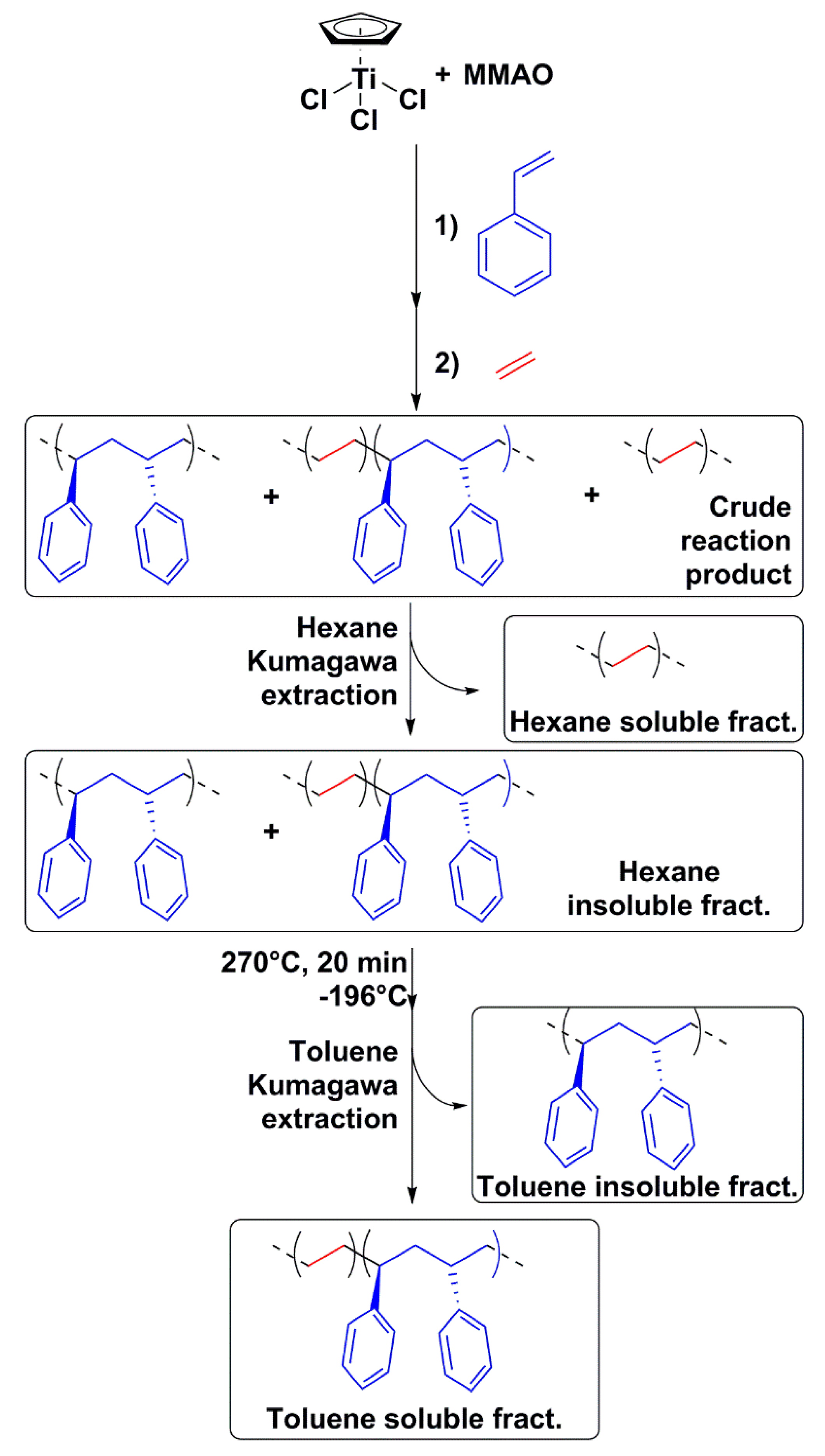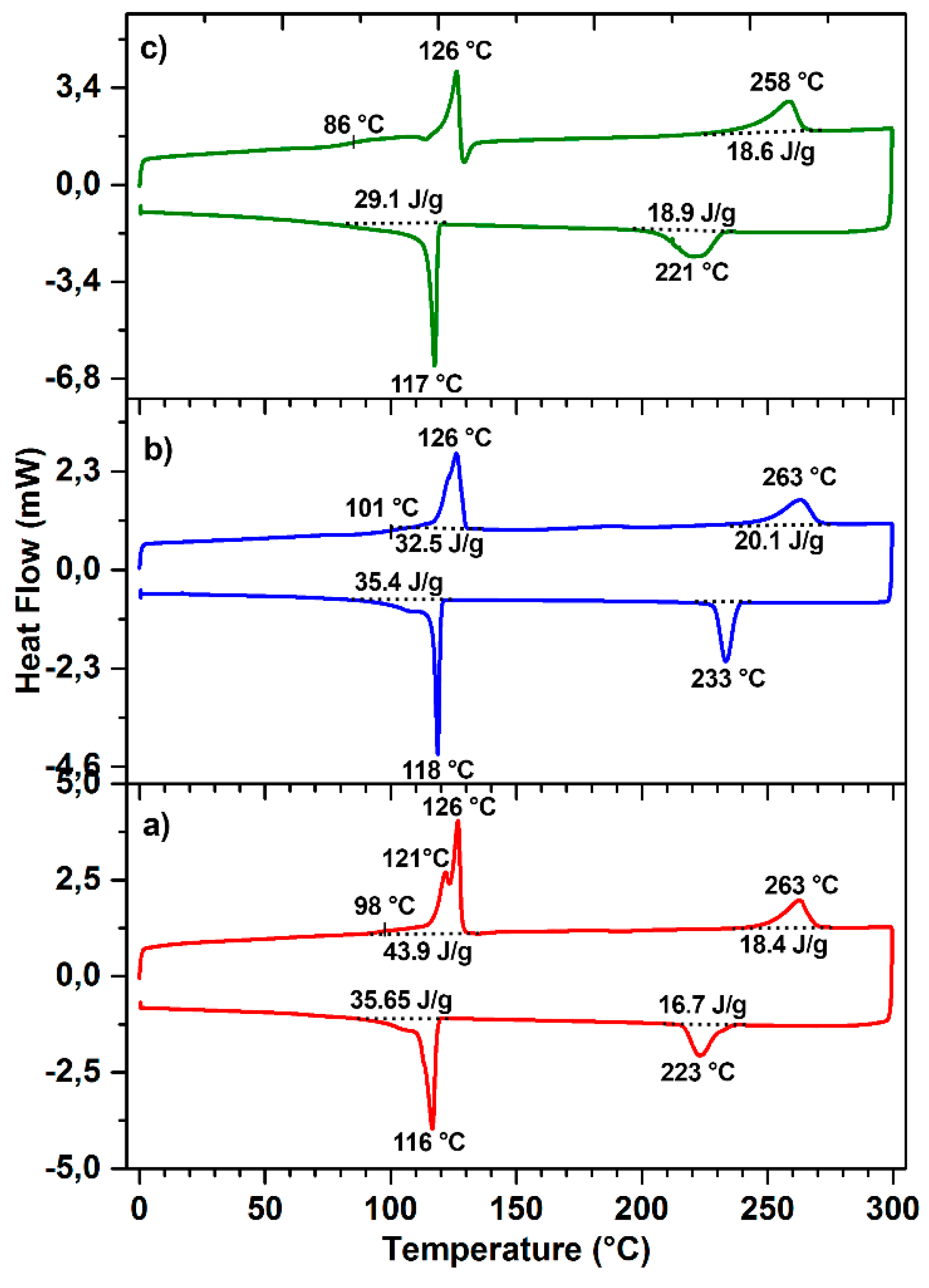Synthesis and Characterization of Syndiotactic Polystyrene-Polyethylene Block Copolymer
Abstract
:1. Introduction
2. Experimental Section
2.1. General Procedures and Materials
2.2. Instruments and Measurements
2.3. Typical Procedure for Ethylene-Styrene Copolymerization
3. Results and Discussion
3.1. Synthesis and Characterization of sPS-b-PE Copolymer
3.2. Crystalline and Thermal Behavior
3.3. Thin Film Morphology
4. Conclusions
Supplementary Materials
Author Contributions
Funding
Acknowledgments
Conflicts of Interest
References
- Ishihara, N.; Seimiya, T.; Kuramoto, M.; Uoi, M. Crystalline syndiotactic polystyrene. Macromolecules 1986, 19, 2464–2465. [Google Scholar] [CrossRef]
- Tomotsu, N.; Newman, T.H.; Takeuchi, M.; Campbell, R., Jr.; Schellenberg, J. Syndiotactic Polystyrene. Chapt.2: Transition Metal Catalysts for Syndiotactic Polystyrene; Schellenberg, J., Ed.; John Wiley & Sons, Inc.: Hoboken, NJ, USA, 2009. [Google Scholar]
- Tomotsu, N. Syndiotactic Polystyrene, Encyclopedia of Polymer Science and Technology; Wiley: Hoboken, NJ, USA, 2011. [Google Scholar]
- Milano, G.; Guerra, G. Understanding at molecular level of nanoporous and co-crystalline materials based on syndiotactic polystyrene. Prog. Mater. Sci. 2009, 54, 68–88. [Google Scholar] [CrossRef]
- Woo, E.M.; Sun, Y.S.; Yang, C.P. Polymorphism, thermal behavior, and crystal stability in syndiotactic polystyrene vs. Its miscible blends. Prog. Polym. Sci. 2001, 26, 945–983. [Google Scholar] [CrossRef]
- Gowd, E.B.; Tashiro, K.; Ramesh, C. Structural phase transitions of syndiotactic polystyrene. Prog. Polym. Sci. 2009, 34, 280–315. [Google Scholar] [CrossRef]
- Guerra, G.; Daniel, C.; Rizzo, P.; Tarallo, O. Advanced materials based on polymer cocrystalline forms. J. Polym. Sci. Part B Polym. Phys. 2012, 50, 305–322. [Google Scholar] [CrossRef]
- Daniel, C.; Guerra, G. Nanoporous crystalline polymer materials for environmental applications. Macromol. Symp. 2016, 369, 19–25. [Google Scholar]
- Buonerba, A.; Impemba, S.; Litta, A.D.; Capacchione, C.; Milione, S.; Grassi, A. Aerobic oxidation and oxidative esterification of 5-hydroxymethylfurfural by gold nanoparticles supported on nanoporous polymer host matrix. ChemSusChem 2018, 11, 3139–3149. [Google Scholar] [CrossRef]
- Galdi, N.; Buonerba, A.; Oliva, L. Olefin–styrene copolymers. Polymers 2016, 8, 405. [Google Scholar] [CrossRef]
- Galdi, N.; Lamparelli, D.H.; Oliva, L. One pot synthesis of linear 1-alkylbenzenes from styrene, ethylene and hydrogen. J. Mol. Catal. A Chem. 2016, 418–419, 154–157. [Google Scholar] [CrossRef]
- Nomura, K. Chapt.5: Copolymerization of ethylene with styrene: Design of efficient transition metal complex catalysts. In Syndiotactic Polystyrene; Schellenberg, J., Ed.; John Wiley & Sons, Inc.: Hoboken, NJ, USA, 2009. [Google Scholar]
- Luo, Y.; Baldamus, J.; Hou, Z. Scandium half-metallocene-catalyzed syndiospecific styrene polymerization and styrene−ethylene copolymerization: Unprecedented incorporation of syndiotactic styrene−styrene sequences in styrene−ethylene copolymers. J. Am. Chem. Soc. 2004, 126, 13910–13911. [Google Scholar] [CrossRef]
- Oliva, L.; Guerra, G.; Caporaso, L.; Izzo, L.; Resconi, L. Propylene copolymers containing styrene units. U.S. Patent US6617410B2, 9 September 2003. [Google Scholar]
- Capacchione, C.; D’Acunzi, M.; Motta, O.; Oliva, L.; Proto, A.; Okuda, J. Isolated ethylene units in isotactic polystyrene chain: Stereocontrol of an isospecific post-metallocene titanium catalyst. Macromol. Chem. Phys. 2004, 205, 370–373. [Google Scholar] [CrossRef]
- Caporaso, L.; Izzo, L.; Sisti, I.; Oliva, L. Stereospecific ethylene−styrene block copolymerization with ansa-zirconocene-based catalyst. Macromolecules 2002, 35, 4866–4870. [Google Scholar] [CrossRef]
- Caporaso, L.; Izzo, L.; Oliva, L. Ethylene as catalyst reactivator in the propene−styrene copolymerization. Macromolecules 1999, 32, 7329–7331. [Google Scholar] [CrossRef]
- Pellecchia, C.; Oliva, L. Ethylene—Styrene copolymerization. Rubber Chem. Technol. 1999, 72, 553–558. [Google Scholar] [CrossRef]
- Venditto, V.; De Tullio, G.; Izzo, L.; Oliva, L. Ethylene−styrene copolymers by ansa-zirconocene- and half-titanocene-based catalysts: Composition, stereoregularity, and crystallinity. Macromolecules 1998, 31, 4027–4029. [Google Scholar] [CrossRef]
- Oliva, L.; Immirzi, A.; Tedesco, C.; Venditto, V.; Proto, A. Ethylene-styrene copolymers by ansa-zirconocene- and half-titanocene-based catalysts: Composition, stereoregularity, and crystallinity. Macromolecules 1998, 31, 4027–4029. [Google Scholar]
- Oliva, L.; Mazza, S.; Longo, P. Copolymerization of ethylene and styrene with monocyclopentadienyltitanium trichloride/methylalumoxane catalyst. Macromol. Chem. Phys. 1996, 197, 3115–3122. [Google Scholar] [CrossRef]
- Oliva, L.; Caporaso, L.; Pellecchia, C.; Zambelli, A. Regiospecificity of ethylene-styrene copolymerization with a homogeneous zirconocene catalyst. Macromolecules 1995, 28, 4665–4667. [Google Scholar] [CrossRef]
- Liu, B.; Wang, L.; Wu, C.; Cui, D. Sequence-controlled ethylene/styrene copolymerization catalyzed by scandium complexes. Polym. Chem. 2019, 10, 235–243. [Google Scholar] [CrossRef]
- Galdi, N.; Buonerba, A.; Oliva, P.; Oliva, L. Nanostructured ethylene-styrene copolymers. Polym. Chem. 2014, 5, 3045–3052. [Google Scholar] [CrossRef]
- Chu, P.P.; Tseng, H.S.; Chen, Y.P.; Yu, D.D. Synthesis and fractionation of syndiotactic-polystyrene/polyethylene copolymers with c5h5ticl3 catalysts. Polymer 2000, 41, 8271–8281. [Google Scholar] [CrossRef]
- Hagihara, H.; Usui, C.; Naga, N. Synthesis of ethylene–styrene copolymer containing syndiotactic polystyrene sequence by trivalent titanium catalyst. Polym. J. 2011, 44, 147. [Google Scholar] [CrossRef]
- Russell, T.P.; Chai, Y. 50th anniversary perspective: Putting the squeeze on polymers: A perspective on polymer thin films and interfaces. Macromolecules 2017, 50, 4597–4609. [Google Scholar] [CrossRef]
- Atanase, L.; Riess, G. Self-assembly of block and graft copolymers in organic solvents: An overview of recent advances. Polymers 2018, 10, 62. [Google Scholar] [CrossRef]
- He, W.-N.; Xu, J.-T. Crystallization assisted self-assembly of semicrystalline block copolymers. Prog. Polym. Sci. 2012, 37, 1350–1400. [Google Scholar] [CrossRef]
- Zambelli, A.; Oliva, L.; Pellecchia, C. Soluble catalysts for syndiotactic polymerization of styrene. Macromolecules 1989, 22, 2129–2130. [Google Scholar] [CrossRef]
- Lapenta, R.; De Simone, N.A.; Buonerba, A.; Talotta, C.; Gaeta, C.; Neri, P.; Grassi, A.; Milione, S. Dinuclear zirconium complex bearing a 1,5-bridged-calix[8]arene ligand as an effective catalyst for the synthesis of macrolactones. Catal. Sci. Technol. 2018, 8, 2716–2727. [Google Scholar] [CrossRef]
- Feil, F.; Harder, S. New stereochemical assignments of 13c nmr signals for predominantly syndiotactic polystyrene. Macromolecules 2003, 36, 3446–3448. [Google Scholar] [CrossRef]
- Longo, P.; Grassi, A.; Oliva, L. Copolymerization of styrene and ethylene in the presence of different syndiospecific catalysts. Makromol. Chem. 1990, 191, 2387–2396. [Google Scholar] [CrossRef]
- Rodrigues, A.-S.; Kirillov, E.; Lehmann, C.W.; Roisnel, T.; Vuillemin, B.; Razavi, A.; Carpentier, J.-F. Allyl ansa-lanthanidocenes: Single-component, single-site catalysts for controlled syndiospecific styrene and styrene–ethylene (co)polymerization. Chem. Eur. J. 2007, 13, 5548–5565. [Google Scholar] [CrossRef]
- Son, K.-S.; Waymouth, R.M. Stereospecific styrene polymerization and ethylene–styrene copolymerization with titanocenes containing a pendant amine donor. J. Polym. Sci., Part A Polym. Chem. 2010, 48, 1579–1585. [Google Scholar] [CrossRef]
- Oliva, L.; Izzo, L.; Longo, P. Copolymerization of ethylene and styrene to a nearly-alternating crystalline copolymer. Macromol. Rapid Commun. 1996, 17, 745–748. [Google Scholar] [CrossRef]
- Randall, J.C. The distribution of stereochemical configurations in polystyrene as observed with 13c nmr. J. Polym. Sci. Polym. Phys. Ed. 1975, 13, 889–899. [Google Scholar] [CrossRef]
- Randall, J.C. A review of high resolution liquid 13carbon nuclear magnetic resonance characterizations of ethylene-based polymers. J. Macromol. Sci. Part C 1989, 29, 201–317. [Google Scholar] [CrossRef]
- Grassi, A.; Zambelli, A.; Laschi, F. Reductive decomposition of cationic half-titanocene(iv) complexes, precursors of the active species in syndiospecific styrene polymerization. Organometallics 1996, 15, 480–482. [Google Scholar] [CrossRef]
- Chatani, Y.; Shimane, Y.; Inagaki, T.; Ijitsu, T.; Yukinari, T.; Shikuma, H. Structural study on syndiotactic polystyrene: 2. Crystal structure of molecular compound with toluene. Polymer 1993, 34, 1620–1624. [Google Scholar] [CrossRef]
- Natta, G.; Corradini, P. General considerations on the structure of crystalline polyhydrocarbons. In Stereoregular Polymers and Stereospecific Polymerizations; Natta, G., Danusso, F., Eds.; Elsevier: Amsterdam, The Netherlands, 1967; pp. 708–742. [Google Scholar]
- Buonerba, A.; Speranza, V.; Grassi, A. Novel synthetic strategy for the sulfonation of polybutadiene and styrene–butadiene copolymers. Macromolecules 2013, 46, 778–784. [Google Scholar] [CrossRef]
- Buonerba, A.; Speranza, V.; Capacchione, C.; Milione, S.; Grassi, A. Improvement of tensile properties, self-healing and recycle of thermoset styrene/2-vinylfuran copolymers via thermal triggered rearrangement of covalent crosslink. Eur. Polym. J. 2018, 99, 368–377. [Google Scholar] [CrossRef]
- Capacchione, C.; De Roma, A.; Buonerba, A.; Speranza, V.; Milione, S.; Grassi, A. Syndiotactic polystyrene-block-poly(methyl methacrylate) copolymer via click chemistry. Macromol. Chem. Phys. 2013, 214, 1990–1997. [Google Scholar] [CrossRef]
- Buonerba, A.; Speranza, V.; Canton, P.; Capacchione, C.; Milione, S.; Grassi, A. Novel nanostructured semicrystalline ionomers by chemoselective sulfonation of multiblock copolymers of syndiotactic polystyrene with polybutadiene. RSC Adv. 2014, 4, 60158–60167. [Google Scholar] [CrossRef]
- Della Monica, F.; Luciano, E.; Buonerba, A.; Grassi, A.; Milione, S.; Capacchione, C. Poly(lactide-co-ε-caprolactone) copolymers prepared using bis-thioetherphenolate group 4 metal complexes: Synthesis, characterization and morphology. RSC Adv. 2014, 4, 51262–51267. [Google Scholar] [CrossRef]
- Naddeo, M.; Buonerba, A.; Luciano, E.; Grassi, A.; Proto, A.; Capacchione, C. Stereoselective polymerization of biosourced terpenes β-myrcene and β-ocimene and their copolymerization with styrene promoted by titanium catalysts. Polymer 2017, 131, 151–159. [Google Scholar] [CrossRef]





© 2019 by the authors. Licensee MDPI, Basel, Switzerland. This article is an open access article distributed under the terms and conditions of the Creative Commons Attribution (CC BY) license (http://creativecommons.org/licenses/by/4.0/).
Share and Cite
Lamparelli, D.H.; Speranza, V.; Camurati, I.; Buonerba, A.; Oliva, L. Synthesis and Characterization of Syndiotactic Polystyrene-Polyethylene Block Copolymer. Polymers 2019, 11, 698. https://doi.org/10.3390/polym11040698
Lamparelli DH, Speranza V, Camurati I, Buonerba A, Oliva L. Synthesis and Characterization of Syndiotactic Polystyrene-Polyethylene Block Copolymer. Polymers. 2019; 11(4):698. https://doi.org/10.3390/polym11040698
Chicago/Turabian StyleLamparelli, David Hermann, Vito Speranza, Isabella Camurati, Antonio Buonerba, and Leone Oliva. 2019. "Synthesis and Characterization of Syndiotactic Polystyrene-Polyethylene Block Copolymer" Polymers 11, no. 4: 698. https://doi.org/10.3390/polym11040698
APA StyleLamparelli, D. H., Speranza, V., Camurati, I., Buonerba, A., & Oliva, L. (2019). Synthesis and Characterization of Syndiotactic Polystyrene-Polyethylene Block Copolymer. Polymers, 11(4), 698. https://doi.org/10.3390/polym11040698







